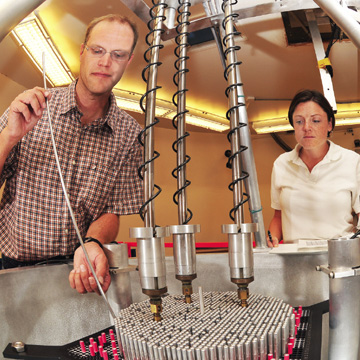
An experiment now being conducted at the Sandia Pulsed Reactor Facility Critical Experiments (SPRF/CX) could lead to more efficient operation of the nation’s nuclear power reactors, potentially saving the industry — and maybe even ratepayers — billions of dollars.
The Seven Percent Critical Experiment (7uPCX) is led by Gary Harms (1384). It is generating data to serve as real-world benchmarks to validate the computer codes used to design fuel element configurations in commercial nuclear reactors.
Today, Gary explains, virtually every commercial reactor in the country is licensed by the Nuclear Regulatory Commission to use nuclear fuel rods that contain up to 5 percent U-235, a fissile isotope of uranium. Fuel rods, about a centimeter in diameter, are bundled together to form the fuel core assemblies in a nuclear reactor.
Because the reaction process by definition consumes the fissile U-235 in the rods, commercial power plant operators periodically need to shut down their reactors to refuel. Reactors are only profitable when they’re online and generating power; shut-down reactors cost time and money.
Commercial reactors around the country, Gary says, “are right up against that 5 percent limit.”
It’s clearly in an operator’s interest to keep reactors online more and shut down less. The good news is, there’s a simple way to achieve that goal: Use a fuel rod that contains more than 5 percent U-235.
As a matter of physics, if fuel rods could contain a higher percentage of fissile material — U-235 — reactors could operate for longer periods between refueling. (Naval reactors use fuel elements with much higher percentages of fissile material; they also go much longer than commercial reactors between refuelings.)
Here’s the dilemma: The NRC licenses held by commercial reactor operators currently stipulate that 5 percent fuel limit. Reactor operators would like to show the NRC that they have reliable models demonstrating that their systems can operate safely using fuel rods with higher percentages of U-235. But how accurate are the models?
That’s where the 7uPCX experiment comes in. In Sandia’s SPR facility, Gary and his team have constructed a small critical assembly — it’s like a baby reactor stripped down to its simplest form — to study the physics of using fuel rods enriched to 7 percent U-235.
Reactor engineers, under Gary’s guidance, meticulously and incrementally add fuel rods to the assembly and monitor the level of fission activity that’s occurring. Ultimately, the number of fuel rods in the core of the assembly is gradually increased until a self-sustaining nuclear chain reaction is achieved.
The data generated in this real-world experiment can be compared to the data generated by computer models. If the models and the real-world data are a close match, that can be taken as one indicator that the models are reliable.
Because of the potential implications of the experiment to the commercial nuclear power industry, Nuclear Facilities and Applied Technologies Dept. 1380 Senior Manager Paul Raglin calls the 7uPCX assembly Sandia’s “billion-dollar reactor.”
Benchmark data generated by 7uPCX will also be used to validate methods used in the criticality safety analyses for shipping and storage configurations for fuel in the 7 percent enrichment range.
The 7uPCX experiment is funded jointly by the DOE/NNSA Nuclear Criticality Safety Program and DOE’s Office of Nuclear Energy (DOE/NE). It is being done in collaboration with Areva Federal Services LLC (a nuclear fuel provider for commercial reactors), Oak Ridge National Laboratory, and the University of Florida. The 7uPCX is a follow-on to criticality experiments done at SPRF/CX in 2002; those earlier experiments were funded by DOE/NE.
SPRF/CX: the future
NNSA’s Nuclear Criticality Safety Program provided substantial funding for the restart earlier this year of the SPRF/CX and has committed baseline funding to maintain a capability to perform critical experiments with low-enriched fuel lattices for the next several years. The NCSP support also ensures that the facility will be ready to perform criticality experiments for other customers without having to go through a costly start-up process for a new nuclear experiment facility.
Over the next several years, the experiments in the SPRF/CX will be used in the training program for Sandia nuclear criticality safety engineers. A collaboration has begun with the Los Alamos Critical Experiment Facility (CEF) to maintain the proficiency of the CEF operators at the SPRF/CX while the CEF is being restarted. For fiscal years 2010 and beyond, the CEF operator training task will transition to more general NCSP hands-on criticality safety training with a training class available to qualify nuclear criticality safety engineers both inside and outside the DOE complex.
Sandia members of the 7uPCX experiment team include: Gary Harms, John Ford, Sid Domingues, Matt Burger, Autumn Higgins, Rick Gomez, and student intern Allison Barber.